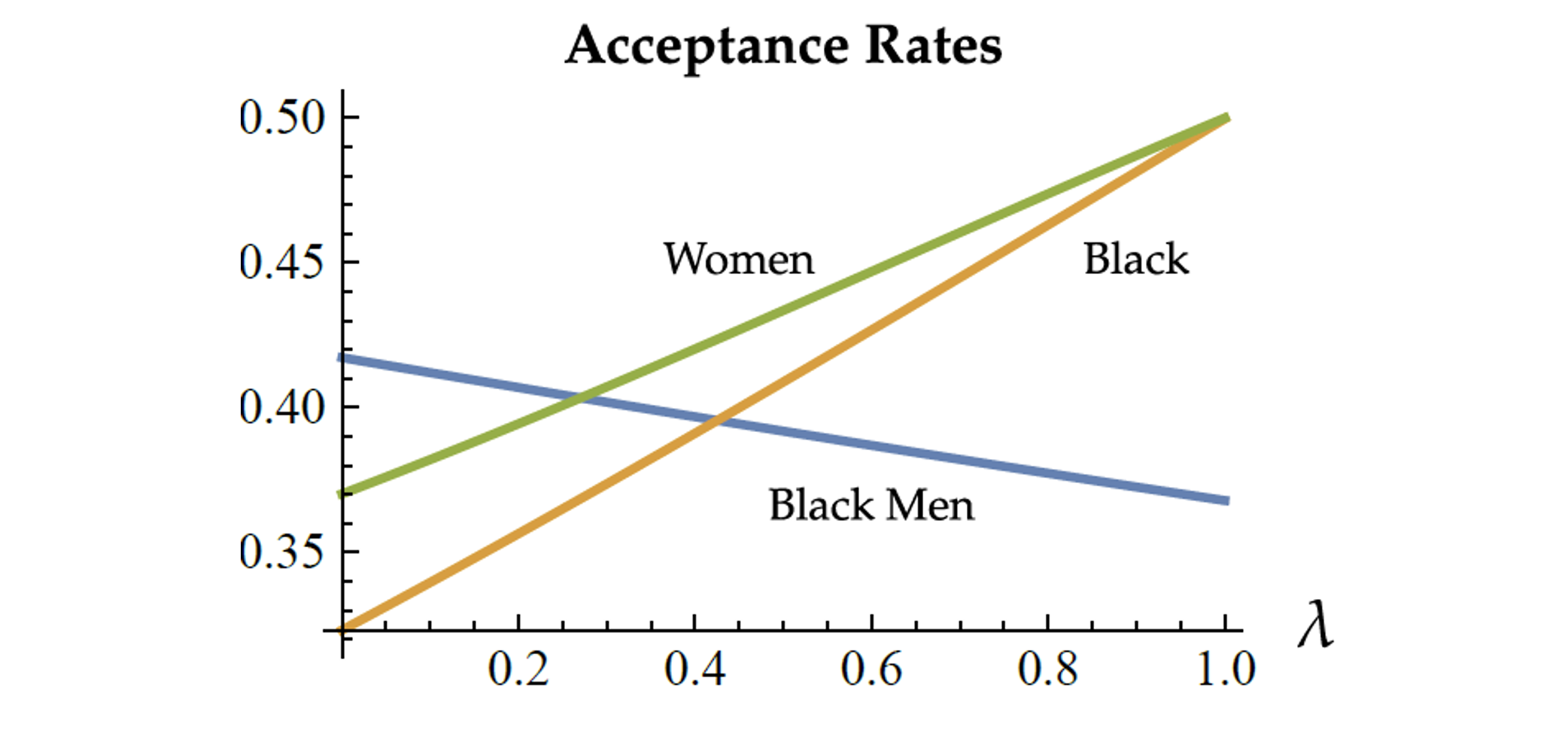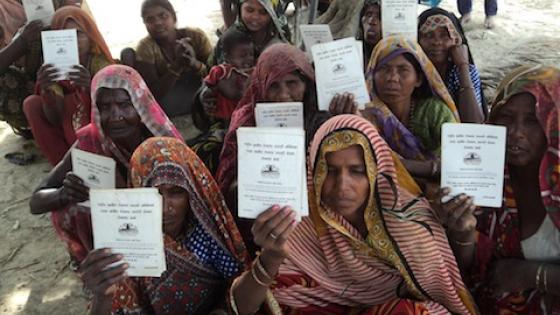Affirmative action policies remain at the forefront of political debate. The US Supreme Court is currently re-evaluating the legality of affirmative action policies in college admissions, as ruled in Grutter v. Bollinger in 2003. In particular, Students for Fair Admissions Inc. is challenging admissions programmes at Harvard University and the University of North Carolina, which use race as a factor in admissions (Howe 2022). A different question is, if affirmative action were practiced, how should such policies be designed (Warikoo 2022)? We take up the latter question in recent research with a focus on the multidimensionality of identity, an important feature that has been largely ignored by economists. Since multiple identity dimensions (e.g. race, sex) are bundled in each person, approaches that ignore interactions between identity dimensions can produce significant analytic and policy errors.
Affirmative action emerged from the Civil Rights movement and originally targeted racial discrimination. Title VII legislation expanded the set of protected categories, banning discrimination on the basis of race, skin colour, religion, gender, and national origin. Numerous other countries have also employed policies aimed at protecting disadvantaged groups and reducing their underrepresentation, including gender representation requirements in parliaments in Chile, France, and Spain (Dolado 2007), caste-based quotas in India (Girard 2018), and reduced university entry requirements for ethnic minorities (youhui zhengce) in China. Today, the representation of groups defined by salient identity characteristics is a major factor in college admissions, private and public sector hiring, government contracts, bank lending, and many other areas (Fryer Jr. and Loury 2005). The aim is to reduce bias in decision making, as well as to adjust for socioeconomic disadvantages faced by groups and various forms of feedback through which underrepresentation reproduces itself.
However, inequality structured by socio-demographic characteristics is mostly analysed in a reductive manner, dimension by dimension. For example, racial inequality is often treated independently of inequality based on gender, class, or religion. Drawing on the unique experiences of Black women, the legal scholar Kimberly Crenshaw (1989) has argued that an individual’s experience is not (just) the sum of their race and gender, coining the term intersectionality. Until now, this issue has been largely ignored by economists, and by policymakers. Regarding the policies of the EU, Skjeie (2015: 79) states: “The dominant equality notion is mainly one-dimensional. What have recently been termed ‘gender+’ equality policies – i.e. policies which address gender inequalities in relation to other inequalities – are rather few and far between”. Conventions for collecting and reporting data are likewise reductive. Even where data are disaggregated based on identity categories such as race and gender, there is seldom information on the performance of the intersectional groups (e.g. Black women). Without this further disaggregation, approaches to addressing structural inequality are incomplete. Our research reveals that an intersectional approach is necessary to understand connections between inequality and underrepresentation across identity dimensions and to design policies aimed at reducing structural inequality.
Representation along socio-demographic lines with intersectional identity
Why does inequality along socio-demographic lines emerge? Different mechanisms have been examined, from taste-based discrimination (Becker 1957), to statistical discrimination (Phelps 1972, Arrow 1974), or norms (Akerlof and Kranton 2000), that can all result in variation along race, gender, and other characteristics. Regarding norms, an outstanding question is how do these emerge? In Carvalho and Pradelski (2022a), we introduce the representation dynamic in which intergroup inequality emerges as a result of identity-specific norms. We posit that the greater a group’s representation in economic activity (e.g. college education, skilled professions), the more ‘normal’ or ‘appropriate’ the activity appears for group members, and the higher the identity-based payoff from participating. Thus, underrepresentation of one's group can become normalised and perpetuated through an identity-based ‘tax’ on participation.
Regarding multidimensional identities, in Carvalho and Pradelski (2022b) we find that the evolution of underrepresentation along different identity dimensions is not independent, but rather interactive. For example, there may be unequal representation along one dimension (e.g. gender) due to inequalities along another dimension (e.g. race). Consequently, if a policymaker alters representation along the gender dimension, they will also affect representation along the race dimension. In fact, ‘sterilised’ interventions along one dimension (that do not affect other identity dimensions) are generically impossible. We show how underrepresentation can be eliminated through either a system of self-financing subsidies or role model interventions, where – importantly – policies are intersectional, i.e. connected across identity dimensions.
Dimension-by-dimension policies generically cannot achieve representative outcomes
Going beyond specific inequality-generating mechanisms, we present a general impossibility result in Carvalho et al. (2022): dimension-by-dimension policies generically cannot achieve representative outcomes.
We consider a decision maker who must select a subset of applicants from an applicant pool. Each applicant has a score (e.g. a test score) and a multidimensional identity. Score distributions can vary across intersectional groups due to various mechanism as discussed above, such as socioeconomic disadvantages, taste-based and statistical discrimination, or norms. We conceptualise an affirmative action policy as follows: The decision maker adjusts each applicant’s score as a function of their identity and then accepts every applicant with an adjusted score above some threshold level. A non-intersectional policy is one in which scores are adjusted independently along each identity dimension (e.g. race, gender). This is the conventional way of formulating affirmative action policies. In contrast, an intersectional policy applies a potentially different adjustment for each intersectional group. Note that, to operationalise intersectional policies, data would need to be available on the intersectional level, which is often not the case.
We find that non-intersectional – dimension-by-dimension – policies generically cannot achieve representative outcomes (whereas intersectional policies can). In fact, such policies can increase the underrepresentation of already underrepresented groups. On the other hand, non-intersectional policies can achieve reductive representative outcomes, that is, each identity dimension is proportionally represented. Importantly, this may lead to the false conclusion that underrepresentation has been eliminated. In fact, the problem could have become worse. A reductive representative policy could increase the underrepresentation of an underrepresented group.
The following example illustrates. Consider a population in which ten percent are Black, the remainder are white, and each racial group is evenly split between men and women. As a result of structural disadvantages for women and black individuals, score distributions vary across groups. Each group's scores are normally distributed with a mean of zero for Black and white women, a mean of 0.25 for Black men, a mean of one for white men, and a unit variance for all groups. Assuming a capacity to admit half of applicants, then without affirmative action, the decision maker would admit roughly a third of both Black and white women, about 42% of black men, and about 70% of white men. Figure 1 shows a non-intersectional policy that achieves a reductive representative outcome. While moving toward the reductive representative outcome has the desirable effect of increasing representation for women and Black individuals, only attending to these two dimensions hides the fact that the policy reduces the representation of Black men. This is due to the rivalry inherent in representation. Even though Black men are recipients of affirmative action, the even larger affirmative action toward women leads to crowding out Black men.
Figure 1 Example of a non-intersectional affirmative action policy
Notes: Acceptance rates for women, black individuals, and black men for the non-intersectional policy lifting scores of women by a=0.925λ and lifting scores of black individuals by b=0.375λ, where λ scales from no intervention (λ = 0) to the non-intersectional policy achieving a reductive representative outcome (λ = 1). While, when λ = 1, the policy achieves a reductive representative outcome, black men are severely underrepresented.
Finally, when only reductive representation is taken into account, odd incentives can emerge: the selection of a minority woman increases representativeness along two dimensions (race/ethnicity and gender) and is thus a ‘double’ improvement. This has in fact been observed in the selection processes for candidates for political office in Belgium and the Netherlands, which turns out to be highly gendered. In both countries, ethnic minority women are represented in larger numbers than ethnic minority men, which is attributed to the strategic choices of party leaders (Celis et al. 2014). Of course, in many other settings, minority women might face a double disadvantage.
The bigger picture
Our findings show that when identities are multidimensional, structural inequality can almost never be eliminated using conventional non-intersectional policies, even approximately. This suggests an intersectional approach should be taken to the measurement and reporting of socio-demographic inequality and the design of affirmative action policies. It does not, however, tell us whether affirmative action based on characteristics such as race and sex should be practiced. One concern expressed by opponents of affirmative action is that such policies make identity-based differences more salient and can thereby amplify structural inequality. The partitioning of society into groups based on ascriptive characteristics is also at odds with liberal individualism. On the other side, it is claimed that this is necessary, at least in the short run, to eliminate structural inequality that is the legacy of historical discrimination. We discuss this in more detail in Carvalho and Pradelski (2022b), showing that identity-based differences and hence group identification vanishes in the limit due to ‘cultural blending’ fostered by mixing between groups. Depending on the environment, affirmative action policies can slow down or speed up this process.
References
Akerlof, G A and R E Kranton (2000), “Economics and identity”, Quarterly Journal of Economics 115(3): 715–753.
Arrow, K J (1974), “The theory of discrimination”, in O Ashenfelter and A Rees (eds.), Discrimination in Labor Markets, Princeton University Press, pp. 3–33.
Becker, G (1957), The Economics of Discrimination, Chicago University Press.
Carvalho, J-P and B Pradelski (2022a), “The Representation Dynamic and the ‘Normalization’ of Group Differences”, working paper.
Carvalho, J-P and B Pradelski (2022b), “Identity and Underrepresentation: Interactions between Race and Gender”, Journal of Public Economics 216(104764).
Carvalho, J-P, B Pradelski and C Williams (2022), “Affirmative action with multidimensional identities”, working paper.
Celis, K, S Erzeel, L Muegge and A Damstra (2014), “Quotas and intersectionality: Ethnicity and gender in candidate selection”, International Political Science Review 35: 41–54.
Crenshaw, K (1989), “Demarginalizing the intersection of race and sex: A black feminist critique of antidiscrimination doctrine, feminist theory and antiracist politics”, University of Chicago Legal Forum, pp. 139–167.
Dolado, J (2007), “Do gender equality laws help?”, VoxEU.org, 12 June.
Fryer Jr, R G and G C Loury (2005), “Affirmative action and its mythology”, Journal of Economic Perspectives 19(3): 147–162.
Girard, V (2018), “When quotas reduce discrimination”, VoxEU.org, 19 May.
Howe, A (2022), “Affirmative action cases up first in November argument calendar”, Scotusblog.com, 3 August.
Phelps, E S (1972), “The statistical theory of racism and sexism”, American Economic Review 62(4): 659–661.
Skjeie, H (2015), “Gender equality and nondiscrimination: How to tackle multiple discrimination effectively”, in F Bettio and S Sansonetti (eds.), Visions for Gender Equality, European Union, pp. 79–82.
Warikoo, N (2022), “College admissions should be about fulfilling institutions’ missions – affirmative can help them do it”, Brookings – Brown Center chalkboard, 20 October.





